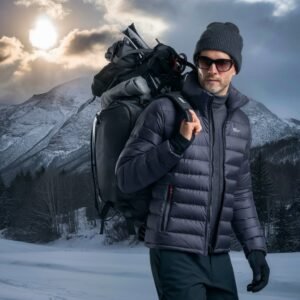Last winter, I embarked on a skiing adventure in the breathtaking French Alps, a trip I had eagerly anticipated for months. Arriving at the picturesque village of Chamonix, I was immediately captivated by the stunning snow-covered peaks and the crisp, invigorating mountain air.
The morning of my first ski day, I woke up early, filled with excitement and a hint of nervousness. After a hearty breakfast at the chalet, I donned my ski gear and headed to the slopes. The weather was perfect—clear blue skies and a brilliant sun that made the snow glisten like diamonds.
I was a bit worried about the prep of the gear and clothing necessary to stay warm, comfortable, and safe on the slopes. So I did a study and made a list of my pack for an enjoyable skiing experience, and I am sure it will help you too. Here it is:
Skiing Gear:
Skis or Snowboard: Choose the appropriate equipment based on your skill level and preference.
Ski Boots or Snowboard Boots: Ensure they fit properly and are compatible with your skis or snowboard.
Ski Poles: Adjustable poles appropriate for your height and skiing style.
Helmet: Provides essential head protection. Always wear a helmet when skiing or snowboarding.
Goggles: Protects eyes from wind, sun glare, and snow. Choose goggles with UV protection and anti-fog features.
Ski Gloves or Mittens: Insulated, waterproof gloves or mittens to keep hands warm and dry.
Base Layers: Moisture-wicking thermal underwear to regulate body temperature and keep you dry.
Mid Layers: Insulating layers such as fleece or down jackets to provide warmth.
Outer Layers: Waterproof and windproof ski jacket and pants to protect against snow and cold temperatures.
Neck Gaiter or Balaclava: Provides additional warmth and protection for the face and neck.
Ski Socks: Moisture-wicking, cushioned socks designed for skiing to keep feet warm and dry.
Hand and Toe Warmers: Disposable warmers to keep hands and feet cozy in cold conditions.
Ski Bag or Snowboard Bag: Protects equipment during transport to and from the ski resort. 
Safety and Accessories:
Avalanche Safety Gear: If skiing in backcountry terrain, bring an avalanche transceiver, probe, and shovel.
First Aid Kit: Includes bandages, antiseptic wipes, pain relievers, and other essentials for minor injuries.
Sunscreen: High SPF sunscreen to protect exposed skin from sunburn, even on overcast days.
Lip Balm: Moisturizing lip balm with SPF to prevent chapped lips in cold, windy conditions.
Ski Pass or Lift Ticket: Essential for accessing ski lifts and slopes at the resort.
Map or Trail Guide: Helps navigate the ski resort and find your way around the slopes.
Cell Phone and Charger: Keep your phone charged for communication and emergencies. 
Clothing:
Insulated Jacket: Provides additional warmth for layering when not skiing.
Fleece or Sweater: Comfortable layer for après-ski activities and lounging.
Warm Hat: Insulated beanie or hat to retain heat and cover ears.
Waterproof Boots: Sturdy, insulated boots for walking around the resort and après-ski.
Casual Clothing: Comfortable clothing for evenings and non-skiing activities.
Miscellaneous:
Backpack: Lightweight backpack to carry essentials such as water, snacks, and extra layers while skiing.
Water Bottle: Stay hydrated on the slopes with a reusable water bottle.
Snacks: High-energy snacks such as trail mix, energy bars, or fruit for quick refueling.
Camera or GoPro: Capture memorable moments on the slopes and scenic views.
Entertainment: Books, magazines, or games for downtime between skiing sessions. 
Optional Extras:
Ski Tuning Kit: Tools for maintaining and tuning skis or snowboard.
Portable Boot Dryer: Helps dry out boots overnight for comfortable wear the next day.
Fitness Tracker: Monitor activity levels and track skiing performance.
Ski Lessons or Guides: Consider booking lessons or hiring a guide for an optimal skiing experience.
Before your trip, check the weather forecast and resort conditions to ensure you’re prepared for the conditions you’ll encounter. Pack efficiently and prioritize essential items to minimize bulk and maximize enjoyment on the slopes.
Tips for Enjoyable Skiing
Whether you’re a novice hitting the slopes for the first time or an experienced skier looking to enhance your experience, these tips will help you make the most of your time on the mountain.
1. Choose the Right Gear
- Proper Fit: Ensure your ski boots fit well; they should be snug but not uncomfortable.
- Appropriate Clothing: Dress in layers to stay warm and dry. Use moisture-wicking base layers, insulating mid-layers, and waterproof outer layers.
- Protective Gear: Wear a helmet for safety and goggles to protect your eyes from UV rays and wind.
2. Stay in Shape
- Pre-Ski Exercise: Strengthen your legs, core, and improve your cardiovascular fitness before hitting the slopes to reduce fatigue and the risk of injury.

3. Take Lessons
- Professional Instruction: If you’re new or want to improve, consider taking lessons from a certified instructor to learn proper techniques and boost your confidence.
4. Start Slow
- Warm-Up Runs: Begin with easier slopes to warm up your muscles and get a feel for the snow conditions.
5. Know Your Limits
- Pace Yourself: Don’t push yourself too hard, especially if you’re tired. Take breaks to rest and hydrate.
6. Stay Hydrated and Eat Well
- Hydration: Drink plenty of water throughout the day to stay hydrated.
- Healthy Snacks: Keep energy levels up with nutritious snacks like nuts, fruit, and energy bars.

7. Check Weather and Snow Conditions
- Plan Ahead: Monitor the weather forecast and snow reports to choose the best days for skiing.
8. Learn to Fall Safely
- Falling Techniques: Learn how to fall to minimize injury. Try to relax and fall to the side, avoiding wrist and head injuries.
9. Use Sunscreen
- UV Protection: Apply sunscreen to exposed skin, even on cloudy days, to protect against sunburn.
10. Respect the Mountain
- Ski Etiquette: Follow the rules of the slopes. Respect other skiers and boarders, and be mindful of trail signs and markers.
11. Stay Connected
- Communication: Ski with a buddy and keep in touch using mobile phones or walkie-talkies. Inform someone of your planned routes.

12. Maintain Your Equipment
- Regular Maintenance: Ensure your skis or snowboard are well-maintained, with sharp edges and properly adjusted bindings.
13. Enjoy the Scenery
- Take It In: Don’t rush. Take moments to stop and appreciate the beautiful mountain scenery.
14. Après-Ski Activities
- Relaxation: Enjoy après-ski activities such as hot tubs, massages, or simply relaxing by the fireplace to soothe tired muscles and unwind.
You can enhance your skiing experience, making it safer, more enjoyable, and memorable, if you follow these tips. Whether you’re carving down a pristine slope or enjoying the après-ski atmosphere, skiing offers a fantastic way to connect with nature and experience the thrill of the mountains.

